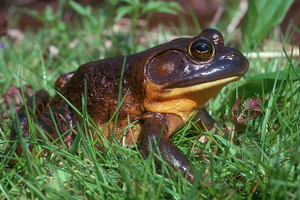Bullfrogs in hand may go limp, then suddenly "revive" and leap away. Sometimes they produce a loud open-mouthed call lasting up to several seconds. When startled along shoreline areas, bullfrogs, especially the young, emit a squawk or bleat as they leap into the water.
Photo Credit: Geoffrey A. Hammerson
Lithobates catesbeianus
Common Name: American bullfrog
Other Common Names: bullfrog
Other Scientific Names: Rana catesbeiana
Animal Guild: Amphibian
Class > Order > Family: Amphibia > Anura > Ranidae
What does the species look like?
Bullfrogs are green or brown, usually with dark spots or mottling (but not large rounded spots). The eardrums are large, with a fold of skin curving around the top and rear edges. The hind toes are more or less fully webbed, but the 4th toe extends beyond the webbing. There are no ridges along each side of the back. Maximum snout-vent length is about 8 inches (20 cm). In mature males, the eardrum usually is distinctly larger than the eye (same diameter in female and young), the throat is yellow during the breeding season, and the base of the thumb is swollen. Expansion of the internal vocal sac in adult males causes a bulging of the throat. The breeding call is a deep bellowing sound. Juveniles are green with many scattered small black dots on the back. In large larvae, the upper surface is green with small black sharp-edged dots (and on tail fin), whereas the upper side is black with gold crossbands in individuals less than one inch (2.5 cm) long. Maximum length of larvae is about 7 inches (18 cm); commonly they are 4 inches long or longer (10+ cm). Eggs are black above, whitish below, deposited in flat jelly masses up to more than 1 meter in diameter and containing thousands of eggs (mass initially floats at surface of water but soon sinks).
Where is the species found?
States & Provinces
AL, AR, AZ, BC, CA, CO, CT, DC, DE, FL, GA, HI, IA, ID, IL, IN, KS, KY, LA, MA, MD, ME, MI, MN, MO, MS, MT, NB, NC, NE, NH, NJ, NM, NS, NV, NY, OH, OK, ON, OR, PA, QC, RI, SC, SD, TN, TX, UT, VA, VT, WA, WI, WV, WY
Distribution
The native range extends from Nova Scotia, New Brunswick, and southern Quebec, Canada, west to the Great Lakes region, and south through most of the central and eastern United States and south into northeastern Mexico. The western limits of the native range are ambiguous due to widespread introductions in western North America. The species also has been introduced and is established in the Greater Antilles, Hawaii, and many other locations worldwide.
American bullfrogs inhabit ponds, swamps, lakes, reservoirs, marshes, brackish ponds (e.g., Hawaii), stream margins, and irrigation ditches, especially sites with abundant floating, emergent, or submerged vegetation. They may disperse from water in wet weather and sometimes are found in temporary waters hundreds of meters from permanent water. Bullfrogs sometimes make seasonal migrations to and from ephemeral bodies of water, or between adjacent permanent aquatic habitats. Individuals often remain in one pond or in a cluster of adjacent ponds throughout a season but may move up to a kilometer or more from one year to the next. Breeding sites are primarily permanent slow- or nonflowing bodies of water.
General Phenology and Life History
Bullfrogs are easily observed in daytime or (with a light) at night; movements and breeding activity during summer occur mostly at dusk and at night, though calling commonly occurs in daytime as well. Bullfrogs are relatively inactive or hibernate during cold winter months, when they situate themselves at the bottom of pools or under various sorts of cover in or near water. Breeding occurs when water temperatures are relatively warm, mainly in May-July in the northern part of the range, primarily late spring to late summer in Georgia, and mainly March through summer in Louisiana. Individual females produce 1-2 clutches/year. Larvae hatch in 4-20 days. In most areas, larvae overwinter at least once before metamorphosing, but larvae metamorphose in less than a year in warm climates (e.g., 5-6 months in Louisiana).
Which phenophases should I observe?
Do you see/hear...?
Activity
Adults on land More...
For abundance, enter the number of individual animals observed in this phenophase.
Adults in water More...
For abundance, enter the number of individual animals observed in this phenophase.
Adults feeding For abundance, enter the number of individual animals observed in this phenophase.
Reproduction
Vocalizing What is the intensity of vocalizing?
Single calls: There is space between calls and individuals can be counted. Overlapping calls: Calls of individuals can be distinguished but there is some overlapping of calls. Full chorus: Calls are constant and overlapping.
Mating For abundance, enter the number of individual animals observed in this phenophase.
Fresh eggs For abundance, enter the number of individual animals observed in this phenophase.
Development
Dead adults For abundance, enter the number of individual animals observed in this phenophase.
What do these phenophases look like?
There is currently no photoguide available for this species. If you'd like help us create one, use the guidance document and species template provided here . Then send it via email to education@usanpn.org when it is complete.
